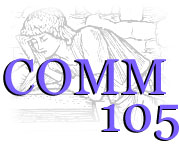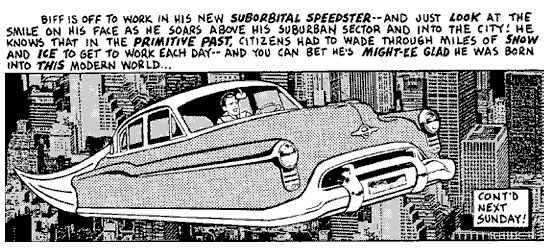
Office: HGH 210; phone: (408) 924-5378
Email: wooda@email.sjsu.edu
Web: http://www.sjsu.edu/faculty/wooda

|
Dr. Andrew Wood Office: HGH 210; phone: (408) 924-5378 Email: wooda@email.sjsu.edu Web: http://www.sjsu.edu/faculty/wooda |
 This Modern World by Tom Tomorrow. This image is used for purposes of academic comment and criticism. |
Examine the image above. It was created for a satirical comic strip that frequently pokes fun at our contemporary love affair with modernism and progress. Tom Tomorrow asserts that corporations sell an ideology of nonstop technological innovation to persuade consumers to buy useless products regardless of their ecological and social costs. What's intriguing about his critique is the use of retro imagery - like the car in this cartoon. Yes, it's a flying car - but, it's a flying car built decades ago. In this way, Tom Tomorrow appears to "date" modernism to an aesthetic and political sensibility located in the 1950s and 1960s. Perhaps, modernism isn't so modern after all.
In his book, Cosmopolis, Stephen Toulmin describes modernism in terms that may remind you of Tom Tomorrow: "the inexhaustible cornucopia of novelty" (p. 5). New products, new opportunities, new frontiers: this is the modern way. The irony is that the structures and buildings of this modern age, emerging from Europe and taking root in the United States, were to replace local, regional, provincial tastes, with an international style of building occupied by interchangeable people. The fruits in this inexhaustible cornucopia looked more and more alike. The glass and steel Seagram Building, designed by Mies van der Rohe and completed in 1958, epitomizes this style. Discussing the Seagram building, Tom Wolfe (1981) describes how structures in the 1950s and 60s were sold as clean, stripped of ornament, and functional to the point of being almost indistinguishable from the machines that built them: "Every respected instrument of architectural opinion and cultivated taste, from Domus to House & Garden, told the urban dwellers that this was living. This was the good taste of today; this was modern, and soon the International Style became simply known as modern architecture" (p. 55, emphasis in original). So what? Why discuss modern architecture in a class called Communication, Self, and Society? Because we seek to study the contexts that shape self. And, one might readily agree that the context of modernism, communicated by its buildings, impacts the self in a substantial manner.
Toulmin, therefore, aids our desire to understand the modern self by proposing that modernism may be understood from its various origins. From a political standpoint, modernism is the formation of stable national entities that streamline and order individual and provincial ambitions. From a technological standpoint, modernism may be defined by the introduction of machines that replaced inefficient and idiosyncratic manufacturing practices with assembly line construction. From a scientific point of view, modernism may be defined as the logical and objective study of physical phenomena, devoid of spiritual or superstitious blinders. From a philosophical perspective, modernism is a little more complicated. On the one hand, the modern individual is freed from church and state to measure the world for his/her own purposes. Machiavelli expounds upon this notion in his Prince. On the other hand, the modern individual must fix his/her identity through the state. Hobbes expounds upon this notion in his Leviathan. This "Enlightenment" conception of self, reaching its apex in the French and American revolutions, contains the seeds for conflict that poisoned Socrates centuries before. The idealized self - composing more individuals than ever before - is freed from classical bonds of region, drudgery, and superstition and simultaneously shackled by increasingly potent modern national obligations. Supremely, however, the modern self is rational. Like a billiard ball, it is free to follow its own course on a theoretically level playing surface and yet bound by immutable rules of law. In response to the all-powerful modern state, what is the philosopher of "self" to do? One might continue to turn philosophy into science, the objective study of prediction and control. Or, one might return to classical studies of virtue. Or, perhaps, one might explore so-called postmodern notions of self.
In contrast to modernism, postmodernism challenges us to question the centrality of the self in contemporary life. The questions posed by postmodernism began with radical alterations in warfare and shifts in the relationship of productivity and consumption. In other words, the ability to kill people indiscriminately - brought to a high level of mechanized efficiency in World War I - forced people to ask whether the modern celebration of the individual could be sustained. Moreover, as many Americans left agricultural and industrial workplaces where they produced things of substance and entered worlds composed primarily of symbols and ideas, some began to wonder whether they produced anything at all. Finally, as Toulmin notes, postmodernism challenges the structures and institutions which shape our identities. The nation state, since the 17th century, has provided a context through which identity, ethnicity, and culture become shaped. However, "the times that we live in demand institutions of new and more functional kinds: institutions that overlap national boundaries and serve transnational social and economic needs" (p. 7, emphasis in original). So, what is postmodernism?
Postmodernism, at heart, is a challenge to the consumer mentality that pervades much of our popular culture - in which ideas, images, symbols, ideologies, spiritual beliefs are sampled, bought, sold, and disposed. It also speaks to the globalizing influences of media, commerce, and leisure which turn local traditions, customs, apparel, crafts, and cultures into raw materials for play and power. The perfect example of the postmodern performer of self is Madonna who wears Catholic garb in one video and Hindu garb the next. These images of culture and belief are easily mixed and matched from a postmodern standpoint because they no longer are connected to things of the world that have substance. Recalling that postmodernism is a critique of perceived flaws in modernism enacted through architecture, advertising, literature, and other forms of human expression, here are some key distinctions between modernism and postmodernism:
|
Modernism
Universal standards |
Postmodernism
Partial truths |
Questions for Consideration
2. When does Toulmin date the origin of modernism and why?
3. According to Toulmin, what is the principle world view of modernism?
4. How might the modern philosophy of Descartes be described?
5. What are some writers and thinkers associated with modernism?
6. What 20th century trends contributed to the emergence of postmodernism?
7. What would be a postmodern ethic?
For further reading
Off-campus Resource
Charles Ess, Resources on Postmodernism and the Habermas/Foucault Debate
Mary Klages, Introduction to Postmodernism: "Postmodernism is hard to define, because it is a concept that appears in a wide variety of disciplines or areas of study, including art, architecture, music, film, literature, sociology, communications, fashion, and technology. It's hard to locate it temporally or historically, because it's not clear exactly when postmodernism begins."
James Lileks, Institute of Official Cheer: "where old pop culture is subjected to our patented Re-Ironization Process, and converted into chipper, spiffy, feather-light postmodern commentary on commercial culture. Or, to put it another way: there's enough here to kill two, maybe three lunch hours."